
Taxi advertising screens give a good return on investment. The global in-taxi digital advertising service market will grow fast. It may go from $1.2 billion in 2022 to over $4.3 billion by 2030. This happens because more people use taxis in cities. New targeting technologies also help. Reports say these screens are easy to see. They show moving content and can target certain places. Advertisers want value for their money. They also want to save money and get real-time data. Taxi operators get new ways to make money. They can also see how well ads work.
Key Takeaways
Taxi advertising screens give good returns because they reach many city riders with moving ads that catch people’s eyes. These screens use GPS and cloud technology to show ads that fit the taxi’s place and time. This makes the ads more useful and work better. Costs change by ad type, but taxi screens save money since there is no printing. They also let ads change fast, and drivers can make extra money. Data and analytics help advertisers see how ads do right away. This lets them change ads quickly to get better results and make more money. Taxi advertising screens are different from billboards and old media. They move through cities, keep riders interested longer, and have interactive features.
Are Taxi Advertising Screens Worth the Investment?

ROI Overview
Taxi advertising screens help brands reach people in cities. These screens show ads to riders while they travel. Passengers see the ads during their whole ride. Advertisers can count how many people see the ads. They can also check if people interact with the ads. This helps brands know if their ads work well.
A big part of ROI is the cost per mille (CPM). CPM means the price to show ads to 1,000 people. The table below shows CPM for different ad types:
Advertising Format | CPM Range (USD) | Notes |
|---|---|---|
Suburban Billboards | $2 – $8 | Static formats |
Premium Urban Locations | $20 – $30 | Static billboards and premium sites |
Programmatic DOOH | $10 – $25 | Digital, impression-based, flexible |
Transit Ads (Bus Wraps, Street Furniture) | Within above ranges | Included as traditional OOH formats |
Taxi advertising screens usually cost about the same as other transit ads. But they give more value with moving ads and location targeting. They also get more people to pay attention. For example, Taxi TV has over 15,000 screens in big U.S. cities. They saw 30% more people see their ads each year. Brands use QR codes and interactive ads to get more people involved. This makes the ads work better.
Real-world examples show taxi screens save money and work well:
Coca-Cola used taxi top LED screens to reach city riders. This helped more people see and remember the brand.
Local restaurants used GPS ads to share deals. This brought in more customers at busy times.
Concerts and events used taxi screens for countdowns and ads. This helped sell more tickets.
These stories show brands can use taxi screens to reach the right people. They can also see real results from their ads.
Market Growth
The market for taxi advertising screens is getting bigger. New tech and changing habits help this growth. Bright LED screens and live updates catch people’s eyes. These screens also give news like traffic and weather. This makes rides better for passengers.
Recent numbers show the market grows by 3.20% each year until 2030. More people move to cities and want ads made just for them. New tech like AI and data tools help show ads in the right places. Asia-Pacific grows fast because cities there are growing and using new tech. North America is also big in this market because of new ideas and interest in ads.
Big companies work together to help the market grow. Verizon, Lyft, and Uber put money into taxi ad screens. They add new features and reach more people. Fun things like games and quizzes make riders pay more attention and like the ads.
Taxi advertising screens are special because they reach people on the go. This makes ads feel more important and easy to remember. As cities get bigger and tech gets better, these screens will be a bigger part of digital ads.
How It Works
Technology Basics
Taxi advertising screens use new technology to show ads. They run on Windows or Android. This lets people control them from far away. You can update ads with a phone or computer.
4G helps send data fast, so ads show up on time. Bad weather does not stop the ads.
WiFi lets taxis get new ads quickly when near a network.
GPS tracks where each taxi goes. This helps show ads for certain places.
Cloud tools let people watch all screens from one spot. They can check if screens work and see what ads play.
LED screens are easy to fix. If something breaks, like a GPS or light sensor, it is easy to swap out.
Light sensors make screens brighter or dimmer by themselves. This helps people see the ads and keeps drivers safe.
Special software keeps track of which ads play. It also shows how the screens work. Advertisers use this data to see if their ads do well.
All these things help taxi advertising screens work well. They are easy to use and fix.
Location Targeting
Taxi advertising screens use GPS and cloud tools to show ads for certain places. The GPS knows where the taxi is all the time. When a taxi goes into a new area, the screen can show ads for stores or events nearby. Advertisers can change ads from far away. They can pick ads for different times or needs.
The screens count how many people see the ads. They also see if people interact with them. For example, a restaurant can show lunch deals when taxis are close. This brings more people in during busy times. Event ads can show up when taxis drive by concert or sports areas. GPS and cloud tools help ads reach the right people at the right time.
Benefits of Taxi Advertising Screens

High Visibility
Taxi advertising screens move through busy city streets every day. These screens reach people in many parts of the city, not just one area. People inside and outside the taxi can see the ads. This moving ad helps brands reach more people than billboards that stay in one place. Studies say digital screens in taxis get more attention than simple ads on buses or trains. Bright pictures on these screens make people want to look at them. Many commuters like these ads, especially when they are fun and fit their interests.
Taxi advertising screens let brands talk to city people right away, so the ads are easier to remember.
Cost-Effectiveness
Taxi advertising screens help brands save money. LED screens do not need printing, so brands do not pay extra. These screens last a long time and do not break easily. Digital screens can change ads fast, so ads always stay new.
Taxi screens work all day and night, so brands get seen all the time.
Moving ads reach more people in different places, so more people know the brand.
Taxi owners make more money by selling ad space in their cars.
Taxi advertising screens use less power than old billboards, so they are better for the earth. Brands can also see how well their ads do, which print ads cannot show.
Flexible Targeting
Taxi advertising screens use GPS and data tools to show the right ad at the right time. Advertisers can pick which ads show in certain places or at certain times. For example, a breakfast ad can play in the morning near offices, and a concert ad can show at night near event places.
Programmatic platforms help brands run ads and change them using real-time data. This lets ads reach different groups, like people going to work or people out late, as taxis drive around the city.
Flexible targeting lets brands reach the right people, at the best time and place.
ROI & Costs
Initial Investment
How much you pay to put digital advertising screens in taxis depends on the type and where you are. Some ads are just on seats, while others cover the whole taxi. The table below shows starting prices in the UK:
Advertising Format | Typical Initial Cost (GBP) | Notes on Variation |
|---|---|---|
Taxi Super Sides | ~£150 | Lower cost, simpler format |
Taxi Partial Livery | ~£750 | Mid-range cost |
Taxi Full Livery | ~£1,000 | Highest cost for full wrap |
Taxi Tip Seats | ~£35 | Lowest cost, small ad space |

In North America, a taxi top LED advertising screen usually costs a bit over $1,000. The price can change if the screen is better or uses special materials. Electric taxis might cost more because they are better for the environment. If you book more taxis or run ads longer, the price per taxi can go down.
Operational Expenses
There are some regular costs to keep screens working well:
Checking and fixing screens often
Having a team to take care of equipment
Making screens look better with new ideas
Using smart systems to watch screens from far away
Paying for the power to run the screens
Fixing and updating screens to keep them working
These costs help screens work without stopping. Better technology can also mean fewer problems and save money later.
Revenue Models
Most taxi advertising programs pay drivers extra money. Drivers get paid for having screens and driving enough hours. For example:
Uber drivers can make about $300 each month, plus a $100 bonus if they drive over 20 hours a week.
Lyft’s Halo Cars gives up to $400 a month to drivers with smart LED screens.
Many programs want drivers to keep screens on and drive a certain amount. Ride-hailing companies and ad tech firms work together to make these programs. When more taxis join, it gets cheaper for everyone and helps them earn more.
Maximizing Returns
Content Optimization
Advertisers can get more people to notice their ads by using smart ideas. AI-powered systems now change ads right away. These systems look at where the taxi is, who is nearby, and what time it is. Machine learning models help pick the best ad for each time. This makes ads feel more personal and work better.
Bright, clear pictures make people look and remember.
Changing ads often keeps them new and interesting.
Fun things like QR codes or social tags let people join in.
GPS and data tools help check how well ads do.
Brands that change their ads a lot and use fun features get more people to pay attention. Fast changes keep ads up to date, and interactive tools make people want to do something.
Data & Analytics
Data and analytics tools help advertisers see how well their ads work. Real-time data shows how many people see each ad. Advertisers can switch ads by hour, area, or even weather. This helps them reach the right people.
Special numbers like Lifetime Value and Share of Voice show how much customers are worth and how far the brand goes.
Attribution models show which ads get the most people to buy.
Marketing Data Governance makes sure data is right and watched all the time.
Promo codes and QR codes give quick feedback on how people react.
These tools help advertisers make quick choices using data. They can change ads fast to get better results and make more money.
Expanding Revenue
Taxi companies and advertisers can find new ways to make money besides normal ads. Rideshare cars now use screens inside, car top displays, and wraps on the outside. These give more space for ads and can cost more.
Drivers get extra money by sharing ad profits.
News and traffic updates on screens get more people to watch.
Touchscreens and mobile links let people interact with ads.
Data from digital signs gives info that companies can sell.
Mobile pay and location-based services help start new businesses.
Cities growing and new tech help more people see ads. Government help for digital taxis also helps the market grow. These changes give more ways to make money and get better returns.
Challenges & Solutions
Content Relevance
Taxi advertising screens need to show ads that matter to riders. Operators have trouble keeping ads new and fun. Riders might ignore ads if they see the same ones a lot. They also might not care if the ads do not match their likes. There are rules that say ads must be honest and fair. Operators cannot show ads that upset or bother people.
Modern LCD screens help fix these problems. They let operators change ads right away. Operators use data and AI to make ads fit the place and people. For example, a screen can show a coffee shop ad near offices in the morning. Fun things like QR codes make ads more interesting. Operators follow rules to keep ads safe and legal.
Challenge | Description | Effective Solutions |
|---|---|---|
Ads must be engaging and relevant to passengers to be effective. | Use data analytics and AI for personalized, location-based ads. | |
Ad Fatigue | Passengers may become disengaged due to repetitive or irrelevant ads. | Employ interactive and dynamic content to maintain engagement. |
Technical Issues
Taxi advertising screens use special hardware and software. Sometimes, operators find problems with wires or the control system. Software can also stop working right. Dust or water can make screens not work well.
Operators fix these problems by following clear steps. They check wires and power often. Each month, they clean and look at the screens. If something breaks, a team comes fast to fix it. Most small problems get fixed in eight hours. Big problems, like changing a part, get fixed in a day. Good care and strong tech keep screens working well.
Regular checks and quick fixes help screens stay on and show ads.
Privacy Concerns
Ads that use location data can cause privacy worries. Operators must ask riders before collecting any data. They should only take what they really need. Using close locations is better when possible.
The best way is to lock all data with codes when sending or saving it. Operators use passwords and special checks to keep data safe. They look at the system often to stop bad use or leaks. Laws like GDPR and CCPA say users can see or delete their data. Operators hide names when sharing data to keep it private.
Operators must:
Ask before taking location data.
Only collect what is needed.
Lock and watch all data for safety.
By doing these things, taxi advertising screens can show the right ads and still protect people’s privacy and trust.
Comparing Taxi Advertising Screens
Versus Digital Billboards
Digital billboards are big and stand in busy places. They show bright ads that move and get attention. Many people see them every day. But digital billboards do not move. They stay in one spot and cannot follow people around the city.
Taxi advertising screens ride with taxis all over the city. They go to many neighborhoods and reach lots of people. People riding in taxis see the screens up close. This means they watch the ads for longer. The screens can change ads when the taxi goes to new places. Advertisers can pick ads for certain streets or events. Taxi screens can update ads fast with cloud tools. This helps brands show the right ad at the best time.
Feature | Digital Billboards | Taxi Advertising Screens |
|---|---|---|
Mobility | Fixed location | Moves throughout city |
Targeting | General area | Location-based, dynamic |
Audience Engagement | Short viewing time | Captive, longer exposure |
Content Updates | Scheduled, less frequent | Real-time, remote updates |
Taxi advertising screens can target better and keep people watching longer than digital billboards.
Versus Traditional Media
TV and print ads have been used for a long time. TV ads reach lots of people, but many skip them or leave. Print ads in newspapers and magazines can be missed. It costs more money to make and change these ads.
Taxi advertising screens are different in many ways:
They get attention inside taxis, where riders cannot look away.
Touch screens and QR codes let people join in with the ads.
Digital ads can change often without printing new ones.
They help the earth by using less paper.
Ads on buses and taxis reach millions every week. Studies say 86% of bus riders remember seeing ads on their trips. This means people remember the brands well. Taxi advertising screens do even better by showing ads often and in many places.
Brands that want cheap and strong ads can use taxi advertising screens for the best results.
Measuring Success
KPIs
Advertisers need simple ways to see if their taxi advertising screens work. Key performance indicators, or KPIs, help companies check how ads do. These KPIs include how long people see the ad, how much they join in, how many click digital parts, and if more people visit stores after seeing the ad. Companies use these numbers to set goals and make ads better next time.
Some main KPIs for taxi advertising screens are:
Reach: How many people saw the ad.
Impressions: How many times the ad showed up, even if the same person saw it again.
Footfall: How many people saw the ad and then went to a store or website.
Touchpoint Conversion: Follows the steps from seeing the ad to buying something.
Frequency: How many times a person sees the ad.
Exposure Time: How long the ad stays on the screen.
These KPIs help brands know if their ads reach the right people and if people do something after seeing the ad.
Tracking Methods
Advertisers use different ways to see how taxi advertising screens work. Touch screens in taxis let riders join in with ads. This helps companies know which ads help make sales. Stores have seen more sales when riders use these screens. Riders also remember brands better when they join in with ads during rides.
Common ways to track ads include:
Using special QR codes, promo codes, or web pages to see who responds and buys.
Doing surveys before and after ads to see if more people know the brand.
Watching website visits for jumps during the ad time.
Checking sales in places where taxis drive to see if ads help.
Looking at social media to see if people talk about the campaign.
Advertisers also check how many people scan QR codes or use promo codes. Digital tools help track how many people join in and see the ads. These ways help brands see how well taxi advertising screens work.
Taxi advertising screens help brands get noticed all over the city. They let brands show ads all day and night. Brands can use videos to catch people’s eyes. Many people see these ads because taxis move everywhere. Brands can pick where and when to show ads for the best results. They can also use data to make ads better and earn more money.
Brands get to use moving ads and reach lots of people.
Ads can be shown at special times or places to work better.
Using data helps brands keep making more money.
Advertisers should try small test ads first. They should use live data to see what works. Trying new ad ideas can help get better results. In the future, taxi advertising screens will use AI, fun features, and green tech to get even better.
FAQ
How do taxi advertising screens target specific locations?
Taxi advertising screens use GPS to know where they are. The system finds the taxi’s spot in the city. It shows ads that match that place. Advertisers can change ads from far away. They can pick ads for different areas or events.
What is the average cost to advertise on taxi screens?
The price depends on the city and how long the ad runs. Most advertisers pay $30 to $50 for each taxi every week. If you book more taxis or run ads longer, the price goes down.
Can advertisers track the effectiveness of their ads?
Yes, they can. Advertisers use QR codes and promo codes to check results. They also use special dashboards to see how ads do. These tools show how many people see and use the ads. Brands can use this data to make ads better.
Are taxi advertising screens disruptive to drivers or passengers?
Modern screens let you change how bright or loud they are. Most screens play videos with no sound. Drivers and riders say the screens do not bother them. Operators check feedback to keep rides comfortable.
See Also
Best Five CarPlay Screens For E90 Models Under Budget
Budget-Friendly Portable CarPlay Choices For BMW F10 Drivers
Cost-Effective Portable CarPlay Solutions For All Vehicle Owners
Audi Tesla-Inspired CarPlay Screens Reviewed By Features And Cost
